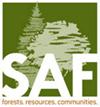Multiple-Pass Harvesting and Spatial Constraints: An Old Technique Applied to a New Problem
IF 1.5
4区 农林科学
Q2 FORESTRY
引用次数: 0
Abstract
A methodology for approximating and incorporating spatial harvesting constraints into forest-level, aspatial models is presented. First, operational cut block scheduling methods based on map-coloring theory are used to sample the number of passes and the percentage of area-per-pass that can be harvested without violating adjacency and exclusion period constraints for a given set of harvesting guidelines. These results are defined as spatial approximation rules, and they are subsequently used to control harvest rates within a spatial approximation model. In test cases, the multiple-pass harvesting technique used in the spatial approximation model appears to closely estimate actual cut block schedules. Two major advantages of the spatial approximation technique are: (1) the onerous task of designing and scheduling cut blocks for an entire forest is not necessary, and (2) policy analysis is enhanced because the spatial approximation rules can be quickly altered to reflect different harvesting guidelines. Model calibration and optimization of harvest timings are identified as areas requiring further research. FOR. SCI. 39(1):137-151.多重采集与空间限制:老技术应用于新问题
本文介绍了一种近似空间采伐约束并将其纳入森林级非空间模型的方法。首先,利用基于地图着色理论的作业伐木区块调度方法,在不违反给定采伐准则集的邻接性和排除期约束条件的情况下,采样可采伐的段落数和每段落可采伐面积的百分比。这些结果被定义为空间近似规则,随后用于控制空间近似模型中的采伐率。在测试案例中,空间近似模型中使用的多次采伐技术似乎可以准确估计实际的砍伐区块时间表。空间近似技术的两大优势是(1) 不需要为整个森林设计和安排伐木区的繁重任务,(2) 由于空间近似规则可以快速改变以反映不同的采伐准则,因此政策分析得到了加强。模型校准和采伐时间优化是需要进一步研究的领域。FOR.SCI.39(1):137-151.
本文章由计算机程序翻译,如有差异,请以英文原文为准。
求助全文
约1分钟内获得全文
求助全文
来源期刊

Forest Science
农林科学-林学
CiteScore
2.80
自引率
7.10%
发文量
45
审稿时长
3 months
期刊介绍:
Forest Science is a peer-reviewed journal publishing fundamental and applied research that explores all aspects of natural and social sciences as they apply to the function and management of the forested ecosystems of the world. Topics include silviculture, forest management, biometrics, economics, entomology & pathology, fire & fuels management, forest ecology, genetics & tree improvement, geospatial technologies, harvesting & utilization, landscape ecology, operations research, forest policy, physiology, recreation, social sciences, soils & hydrology, and wildlife management.
Forest Science is published bimonthly in February, April, June, August, October, and December.
 求助内容:
求助内容: 应助结果提醒方式:
应助结果提醒方式:


